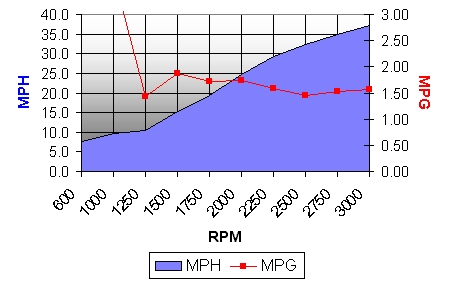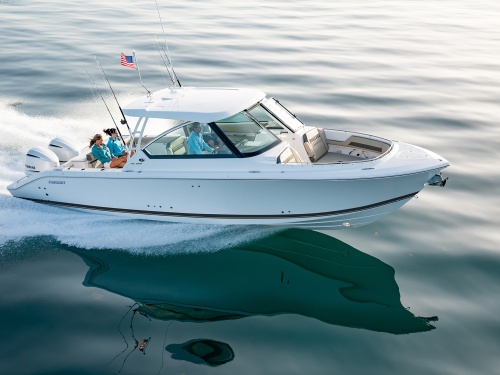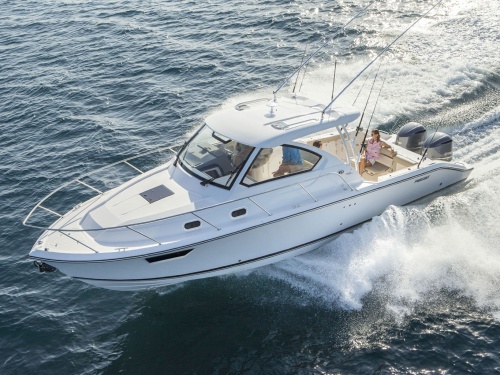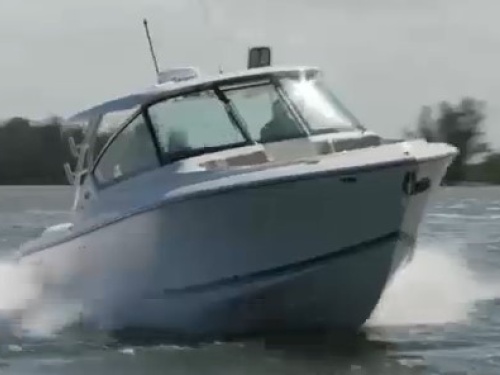Access More Boat Tests
Already have an account? Login
Pursuit 3000 Express
2 x 250-hp Cummins 4B - Diesel
Brief Summary
The Pursuit 3000 Express is a boat made to run with much larger boats on blue water tournaments. She is a rugged offshore fishing machine that has quality features and accommodations for four. With diesels under her hood the 3000 Express is now more fuel-efficient, powerful and most importantly, reliable.
Key Features
The cockpit has more than 52-square feet of fighting area with bolster padding all around. Other cockpit features include four Lee rod holders, a raw-water washdown and a removable fishbox (with macerator pump) in the transom sole. A raised bridgedeck lifts electrically to expose the engines, and there’s good access room. Up on the bridgedeck there’s an L-shaped lounge for two that is fully adjustable and sits just ahead of the bait-prep console with sink, cutting surface and tackle drawers. The entire helm tilts back for easy access, and the airline style multi-function gauges by Faria are easy to read at a glance. Down below, the cabin is trimmed entirely in teak, and the centerpiece is a heavy-duty teak dinette table with maple inlays. Even though the galley is compact it still comes complete with dual-voltage Norcold refrigerator, single-burner stove, and sink. Standing headroom is nearly 6’1” all the way up to the forward berth, as well as in the full-size head.
Test Results
| RPM | MPH | Knots | GPH | MPG | NMPG | STAT. MILE | NM | dBa |
|---|---|---|---|---|---|---|---|---|
| 600 | 7.7 | 6.7 | 1.8 | 4.28 | 3.72 | 839 | 730 | 79 |
| 1000 | 9.8 | 8.5 | 2.6 | 3.77 | 3.28 | 740 | 643 | 80 |
| 1250 | 10.6 | 9.2 | 7.4 | 1.43 | 1.24 | 280 | 243 | 85 |
| 1500 | 15.3 | 13.3 | 8.2 | 1.87 | 1.62 | 366 | 318 | 85 |
| 1750 | 19.4 | 16.8 | 11.2 | 1.73 | 1.5 | 339 | 295 | 86 |
| 2000 | 24.8 | 21.6 | 14.2 | 1.75 | 1.52 | 343 | 298 | 87 |
| 2250 | 29.2 | 25.4 | 18.4 | 1.59 | 1.38 | 311 | 271 | 88 |
| 2500 | 32.3 | 28.1 | 22.2 | 1.45 | 1.27 | 285 | 248 | 89 |
| 2750 | 34.8 | 30.3 | 22.8 | 1.53 | 1.33 | 299 | 260 | 92 |
| 3000 | 37.2 | 32.3 | 23.6 | 1.57 | 1.37 | 309 | 269 | 92 |

Specifications
| Length Overall | 32' 8 |
|---|---|
| Beam | 10' 6 |
| Dry Weight | 10,000 lbs. |
| Draft | 2' 8 |
| Max Headroom | n/a |
| Bridge Clearance | 9' 6 |
| Fuel Capacity | 218 gal. |
| Water Capacity | 30 gal. |
Acceleration Times & Conditions
| Time to Plane | n/a |
|---|---|
| 0 to 30 | n/a |
| Ratio | 1.56:1 |
| Props | 19x23 |
| Load | -fuel, -water, 4 persons on board, min. cruising gear |
| Climate | Temp: 75F, Humid: 70%, Wind: 5-10 knots, Seas: 1-2 feet |
Engine Options
| Tested Engine |
2 x 250-hp Cummins 4B - Diesel |
|---|---|
| Std. Power |
2x300-hp MerCruiser Horizon |
| Opt. Power |
2x250-hp Cummins 4B |
Captain's Report
By BoatTEST.com Test Team
Diesel power. It's been the hallmark of big sportfisherman and motoryachts since they first came down the ways. Diesels are powerful, reliable, fuel-efficient, and their smooth rumblings give a sense of security to anyone working 100 miles offshore. The downside? They cost more than gasoline engines, and frankly, they're just BIG, so up until recently they've been found only on the larger vessels. But thanks to recent innovations, today's diesels are smaller, lighter, and carry a higher horsepower-to-weight ratio than ever before, making them available and economical for boats in the 30-foot range. A great new example of this is found in a rugged offshore fishing machine, the new 3000 Express from Pursuit.
Unlike some other boats in this size range, the 3000 Express does not have an identity crisis. She's a 30-foot offshore fishboat, pure and simple, but with plenty of the goodies and quality features we've come to expect from Pursuit. The fact that she also happens to have comfortable overnight accommodations for four adults takes nothing away from her fishing amenities, but you won't find any foredeck sunpads or cockpit lounges here. In short, this boat was built to run with the big boys in any bluewater tournament around the world.
For a thirty-footer, the 3000 is exceptionally beefy, and a quick look shows Pursuit didn't skimp on hull construction or hardware. The stringer system is first plywood and foam-filled, then encapsulated in fiberglass for stiffness and water-resistance. The powerplants--a pair of 250-hp Cummins 4B diesels on our test boat--are bolted straight-down through vibration-dampening mounts that are in turn bolted directly atop the stringers--no shaky L-angle brackets here. For watertightness, the boat has no thru-hull packing systems. Rather, Tides Marine dripless shaft seals are on both the 1 1/2" Aquamet 22 prop shafts AND around the rudder posts, where they lead through the hull to rugged bronze axe-head rudders. As we'll see in a moment, both the placement and size of the rudders led to a somewhat starling performance at speed.
The top-rate construction on the 3000 Express continues topside as well. All cleats are 316L stainless steel, as is the single-piece welded bowrail that rises to a safe mid-thigh height all the way up to the bow pulpit. Sternlines are lead through chrome-plated bronze hawsepipes down to the inwale cleats, and even the hinge-hardware on the flip-down cockpit benchseat is stainless steel. And then there's the massive, four-panel aluminum windshield with "starboard" wind deflectors that's so high, even Larry Bird couldn't see over the top from the standing position. It's probably the tallest windshield on any boat in this size range, and that means only one thing--a well-protected, dry ride for the helmsman when the weather goes south.
As a fishboat, the 3000 Express may not be all that innovative, but she's certainly packed with all the essentials (and then some) as standard equipment. The cockpit--with its proven diamond-pattern nonskid surface--has more than 52-square feet of fighting area, and I appreciated the side gutters and four scuppers aft that drain the cockpit quickly if you ship a lot of water when backing down hard (a scenario made less likely thanks to a slight rounding of the transom). Cockpit bolster padding is standard all around, as are four Lee rod holders, raw-water washdown, and a heavy-duty transom door that swings OUT to conserve fighting space in the cockpit. One innovation here is found in the flip-down aft bench seat for two. It has no support legs--rather, it flips down quickly and the "starboard" panel that supports the cushion locks firmly into a hidden slot in the transom. This makes the cockpit easy to clean, and even easier to clear when a big one starts smokin' a reel. I also appreciated the easy access to the optional 34-gallon circulating livewell in the forward port corner, as well as the large athwartships removable fishbox (with macerator pump) in the transom sole. The only thing missing is a way to hold up the lid while you flop in a fish or stow your cleaning gear.
As is tradition for Pursuit and Tiara Express models, the raised bridgedeck lifts electrically to expose the powerplants below. While space is understandably tight in the engine room (remember, the beam of the boat is only 10'6"!), all hoses and wiring are well-secured, though not labeled. This method gives you great access to the transmissions, shafts, and raw-water strainers, but for routine fluid-checks you'll use the smaller day hatch in the bridgedeck sole. For major engine work, the entire sole can be removed simply by unscrewing the forward stainless steel hinges and lifting the deck off--seats and all--in one fell swoop.
Up on the bridgedeck itself, an L-shaped lounge for two sits across from the ladder-back helm chair to starboard. This seat is fully adjustable, and sits just ahead of a bait-prep console with sink, cutting surface, and built-in locker with four plastic tackle drawers (an entertainment console with refrigerator or icemaker is an option). An aft-facing jump seat is standard for watching baits, and though there's a small cooler beneath its cushion, it drains directly onto the cockpit sole, so water will dribble onto the sole as the ice melts within.
The helm itself is traditional, high-quality Pursuit, with its near-vertical dash and anodized aluminum destroyer-type wheel. The entire console tilts aft for easy access to the wiring, and our test boat came with a full complement of electronics--radar/electronic chart, LCD fishfinder, and VHF radio--by Raytheon. The aircraft-style multi-function gauges by Faria were easy to read at a glance, and it was an easy reach to the Morse controls from either the seated or standing position. My only objection here has to do with the side vents in the windshield--they have a sharp corner that points forward when the vents are open, and anyone walking aft along the wide sidedecks runs the risk of piercing a shin. While they do a nice job of ventilation, sooner or later somebody's gonna take a vent in the leg. So even though it’s a pricier method, the centerline opening windshield vent would be a safer way to go.
It's three steps down to the interior which is very well-equipped for a 30-foot fishing machine. The cabin is trimmed entirely in teak, and the centerpiece is a heavy-duty teak dinette table with maple insets and a brass marlin inlaid in its surface. The table is supported by a rugged gas-assist post, so it converts quickly from a table to the base of a double berth. Across to port is compact galley with sink, dual-voltage Norcold refrigerator, single-burner Kenyon stove, and recessed stowage built into an FPR Granitcote countertop surface. Forward, there's a separate hanging locker and angled double berth with stowage below. I appreciated the fact that standing headroom is 6'1" nearly all the way up to the forward berth, as well as the full size of the head, with its Vacuflush toilet, shower, and full-length mirror. All in all, it's an interior package that's more than comfortable for a family on an extended weekend fishing trip.
But comfort aside, it may be the fuel-efficiency of the diesels and their performance that lures the fisherman to the 3000 Express. While the boat is slow to get up on plane (about 10 seconds) and so she won't do well as a ski boat, she powered her way to a top-end speed of nearly 40 mph while burning just 23 GALLONS of fuel per hour! Compare that to a gas boat and then start doing the math. At best cruise of 2000 rpm, she has a range of nearly 350 miles, and she sliced through big boat wakes smoothly and was quick to settle down in a beam sea. The helm is extremely light to the touch, and she shoulders down deeply in a turn without any hint of cavitation. She's also highly responsive, and she dodged her way through a field of crab pots more like a bowrider than the offshore fishboat she is.
In short, the team of Cummins diesel and Pursuit design has finally made the small, family-oriented diesel fishboat an affordable force to be reckoned with out on the tournament trail.




